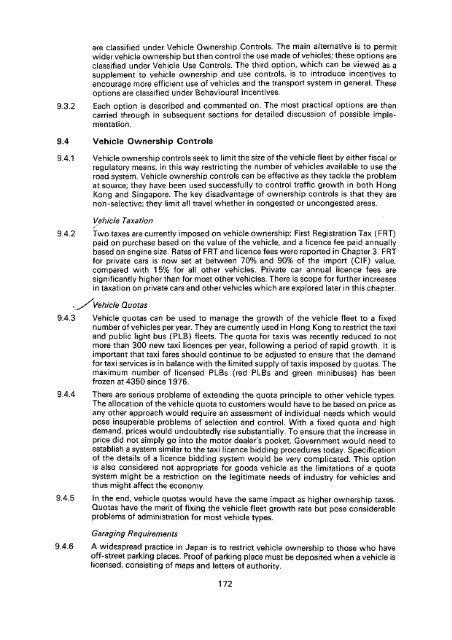Untitled - HKU Libraries - The University of Hong Kong
Untitled - HKU Libraries - The University of Hong Kong
Untitled - HKU Libraries - The University of Hong Kong
- No tags were found...
You also want an ePaper? Increase the reach of your titles
YUMPU automatically turns print PDFs into web optimized ePapers that Google loves.
are classified under Vehicle Ownership Controls. <strong>The</strong> main alternative is to permitwider vehicle ownership but then control the use made <strong>of</strong> vehicles; these options areclassified under Vehicle Use Controls. <strong>The</strong> third option, which can be viewed as asupplement to vehicle ownership and use controls, is to introduce incentives toencourage more efficient use <strong>of</strong> vehicles and the transport system in general. <strong>The</strong>seoptions are classified under Behavioural Incentives.9.3.2 Each option is described and commented on. <strong>The</strong> most practical options are thencarried through in subsequent sections for detailed discussion <strong>of</strong> possible implementation.9.4 Vehicle Ownership Controls9.4.1 Vehicle ownership controls seek to limit the size <strong>of</strong> the vehicle fleet by either fiscal orregulatory means, in this way restricting the number <strong>of</strong> vehicles available to use theroad system. Vehicle ownership controls can be effective as they tackle the problemat source; they have been used successfully to control traffic growth in both <strong>Hong</strong><strong>Kong</strong> and Singapore. <strong>The</strong> key disadvantage <strong>of</strong> ownership controls is that they arenon-selective; they limit all travel whether in congested or uncongested areas.Vehicle Taxation9.4.2 Two taxes are currently imposed on vehicle ownership: First Registration Tax (FRT)paid on purchase based on the value <strong>of</strong> the vehicle, and a licence fee paid annuallybased on engine size. Rates <strong>of</strong> FRT and licence fees were reported in Chapter 3. FRTfor private cars is now set at between 70% and 90% <strong>of</strong> the import (GIF) value,compared with 15% for all other vehicles. Private car annual licence fees aresignificantly higher than for most other vehicles. <strong>The</strong>re is scope for further increasesin taxation on private cars and other vehicles which are explored later in this chapter.Sty^Vfehicle Quotas9.4.3 Vehicle quotas can be used to manage the growth <strong>of</strong> the vehicle fleet to a fixednumber <strong>of</strong> vehicles per year. <strong>The</strong>y are currently used in <strong>Hong</strong> <strong>Kong</strong> to restrict the taxiand public light bus (PLB) fleets. <strong>The</strong> quota for taxis was recently reduced to notmore than 300 new taxi licences per year, following a period <strong>of</strong> rapid growth. It isimportant that taxi fares should continue to be adjusted to ensure that the demandfor taxi services is in balance with the limited supply <strong>of</strong> taxis imposed by quotas. <strong>The</strong>maximum number <strong>of</strong> licensed PLBs (red PLBs and green minibuses) has beenfrozen at 4350 since 1976.9.4.4 <strong>The</strong>re are serious problems <strong>of</strong> extending the quota principle to other vehicle types.<strong>The</strong> allocation <strong>of</strong> the vehicle quota to customers would have to be based on price asany other approach would require an assessment <strong>of</strong> individual needs which wouldpose insuperable problems <strong>of</strong> selection and control. With a fixed quota and highdemand, prices would undoubtedly rise substantially. To ensure that the increase inprice did not simply go into the motor dealer's pocket, Government would need toestablish a system similar to the taxi licence bidding procedures today. Specification<strong>of</strong> the details <strong>of</strong> a licence bidding system would be very complicated. This optionis also considered not appropriate for goods vehicle as the limitations <strong>of</strong> a quotasystem might be a restriction on the legitimate needs <strong>of</strong> industry for vehicles andthus might affect the economy.9.4.5 In the end, vehicle quotas would have the same impact as higher ownership taxes.Quotas have the merit <strong>of</strong> fixing the vehicle fleet growth rate but pose considerableproblems <strong>of</strong> administration for most vehicle types.Garaging Requirements9.4.6 A widespread practice in Japan is to restrict vehicle ownership to those who have<strong>of</strong>f-street parking places. Pro<strong>of</strong> <strong>of</strong> parking place must be deposited when a vehicle islicensed, consisting <strong>of</strong> maps and letters <strong>of</strong> authority.172
















